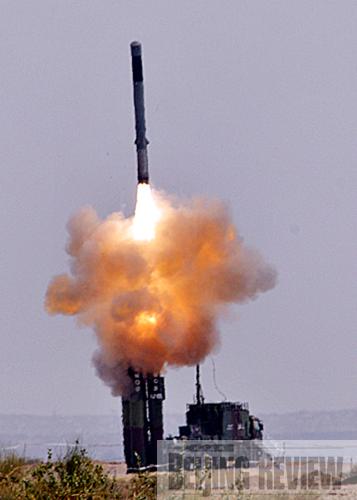|
 |
|
TEST FIRE: India's military successfully tests a surface-to-surface version of the BrahMos cruise missile at the Pokhran range in the western desert state of Rajasthan on March 29. The BrahMos has a range of 290 km and can carry a 300-kg conventional warhead (XINHUA/AFP) |
Recent years have seen great pro-gress in India's ballistic missile defense program. On March 6, it destroyed a missile target about 75 km over the Bay of Bengal with an interceptor missile launched from the Integrated Test Range on Wheeler Island. This was the fourth successful anti-ballistic missile test it has conducted since 2006.
India is the fourth country with anti-ballistic capability after the United States, Russia and Israel. Amid rising regional tension, in 1995 the country purchased the S-300 air defense system from Russia to protect New Delhi and other cities. It intended to purchase the Arrow II missile defense system jointly developed by Israel and the United States after an armed conflict broke out between India and Pakistan in Kargil in the disputed territory of Kashmir in 1999. When the United States rejected its demand, India decided to develop its own missile defense system. The Department of Defense under India's Ministry of Defense created a committee in August 2004 to take charge of the research and development of the country's missile defense system, marking India's formal incorporation of the development of a missile defense system as part of its military strategy.
About 40 public and private companies are involved in the development of India's missile defense system. For example, the Electronics and Radar Development Establishment under the Defense Research and Development Organization (DRDO) undertakes the research and development of the long-range tracking radar and the multifunction fire control radar. DRDO's Defense Research and Development Laboratory is responsible for the control software.
Two phases
India seeks to build a ballistic missile defense system in two phases. The first phase focuses on intercepting missiles with a range of less than 2,000 km. In the second phase, India will pursue the capacity to engage missiles with a range of 3,500 km and above, including intercontinental ballistic missiles.
India has developed the Prithvi Air Defense (PAD) system and the Advanced Air Defense (AAD) system in the first phase of its missile defense program. The PAD system is designed to intercept missiles high in the atmosphere at an altitude of 45 km to 80 km. The missile tested this March was a PAD interceptor. The PAD system was first tested in November 2006, when a PAD missile successfully intercepted a Prithvi II missile at an altitude of 48 km.
The AAD system aims at missiles in the lower atmosphere at an altitude of 15 km to 30 km. To date, India has conducted two AAD tests, both of which were successful. The DRDO said India would carry out another AAD missile interception by the end of this year.
Early warning is an important part of a missile defense system. India is currently developing an early warning trinity with land, air and space-based systems. Its land-based early warning system consists of the Green Pine radar system imported from Israel, with a detection range of some 500 km, and the Swordfish long range tracking radar system India has developed on the basis of the Green Pine system. The Swordfish system currently has a detection range of 600 km, which India is planning to increase to 1,500 km by 2011.
| 